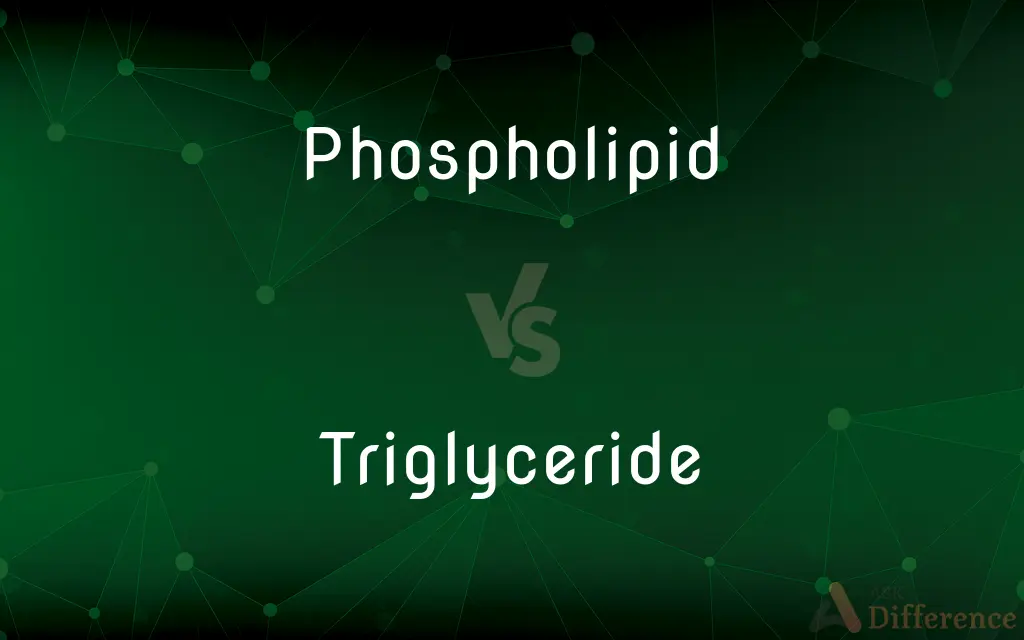Phospholipid vs. Triglyceride — What's the Difference?
By Maham Liaqat & Fiza Rafique — Updated on April 17, 2024
Phospholipids are key components of cell membranes, featuring a phosphate group head and fatty acid tails, while triglycerides, composed of three fatty acids linked to glycerol, are the main form of fat stored in the body.

Difference Between Phospholipid and Triglyceride
Table of Contents
ADVERTISEMENT
Key Differences
Phospholipids consist of a glycerol backbone, two fatty acid tails, and a phosphate group, which makes them amphipathic—capable of interacting with both water and fat. Triglycerides, on the other hand, are made up of one glycerol molecule bonded to three fatty acids and are primarily hydrophobic, meaning they do not interact well with water.
The amphipathic nature of phospholipids allows them to form the bilayer of cell membranes, with the hydrophilic (water-attracting) heads facing outward and the hydrophobic (water-repelling) tails tucked inside. Triglycerides, whereas, are stored in fat cells and do not form such structures, serving instead as long-term energy reserves.
Phospholipids are essential for cell membrane integrity and function, facilitating the movement of substances across the membrane and contributing to cellular signaling. Leggings, on the other hand, act as a significant energy source, especially during periods of fasting or prolonged exercise.
In biological systems, phospholipids can help transport lipids in the bloodstream, thanks to their ability to emulsify fats. Triglycerides are transported as part of lipoproteins but are more involved in energy metabolism than in structural or regulatory functions.
Phospholipids can be modified with various groups like choline or serine, affecting their function and location within cellular membranes. Triglycerides are more uniform in function and primarily vary in the types of fatty acids they contain, which can influence their physical properties and nutritional impact.
ADVERTISEMENT
Comparison Chart
Structure
Glycerol, two fatty acids, phosphate group
Glycerol and three fatty acids
Solubility
Amphipathic (mixes with fat and water)
Hydrophobic (does not mix with water)
Role in the Body
Cell membrane structure, signaling
Energy storage, insulation, protection
Presence in Foods
Eggs, soybeans, peanuts
Oils, butter, animal fats
Health Impact
Essential for cell function
Excess can lead to health issues like heart disease
Compare with Definitions
Phospholipid
Found in all living organisms, from bacteria to mammals.
Regardless of the type of organism, phospholipids are essential components of virtually every cell membrane.
Triglyceride
The main form of fat stored in the body, providing energy and insulation.
Triglycerides are broken down during exercise to provide energy for muscle activity.
Phospholipid
Contains a phosphate group that makes part of the molecule attract water.
The phosphate group in phospholipids helps them to interact with the aqueous environment inside and outside the cell.
Triglyceride
Consist of three fatty acids attached to a glycerol backbone.
The chemical structure of triglycerides enables dense energy storage in fat cells.
Phospholipid
A lipid molecule that is a fundamental part of the cell membrane structure.
Phospholipids arrange themselves in a bilayer, forming the framework of cellular membranes.
Triglyceride
Predominantly found in oils and fats consumed in the diet.
Most dietary fats, whether from animal sources or plants, are in the form of triglycerides.
Phospholipid
Crucial for cell signaling and substance transport across membranes.
Signaling molecules often attach to phospholipids in the membrane to initiate cellular responses.
Triglyceride
Hydrophobic molecules that do not mix with water.
Due to their hydrophobic nature, triglycerides form the core of lipoprotein particles to be transported in the blood.
Phospholipid
Can be modified to perform specific functions in different cells.
In nerve cells, phospholipids are often modified to improve electrical insulation and signal transmission.
Triglyceride
High levels in the blood can be a risk factor for heart disease.
Managing triglyceride levels is crucial for cardiovascular health, particularly in patients with diabetes.
Phospholipid
Phospholipids, also known as phosphatides, are a class of lipids whose molecule has a hydrophilic "head" containing a phosphate group, and two hydrophobic "tails" derived from fatty acids, joined by a glycerol molecule. Marine phospholipids typically have omega-3 fatty acids EPA and DHA integrated as part of the phospholipid molecule.
Triglyceride
A triglyceride (TG, triacylglycerol, TAG, or triacylglyceride) is an ester derived from glycerol and three fatty acids (from tri- and glyceride). Triglycerides are the main constituents of body fat in humans and other vertebrates, as well as vegetable fat.
Phospholipid
A lipid containing a phosphate group in its molecule, e.g. phosphatidylcholine.
Triglyceride
An ester formed from glycerol and three fatty acid groups. Triglycerides are the main constituents of natural fats and oils.
Phospholipid
Any of various phosphorus-containing lipids, such as lecithin and cephalin, that are composed mainly of fatty acids, a phosphate group, and a simple organic molecule. Also called phosphatide.
Triglyceride
Any of a class of compounds that consist of an ester of glycerol with three fatty acids and that are the chief constituents of fats and oils.
Phospholipid
(organic compound) Any lipid, such as lecithin or cephalin, consisting of a diglyceride combined with a phosphate group and a simple organic molecule such as choline or ethanolamine; they are important constituents of biological membranes.
Triglyceride
(organic chemistry) A lipid, an ester of glycerol and three fatty acids (the same or different); the major constituent of animal and vegetable fats
Phospholipid
Any of various compounds composed of fatty acids and phosphoric acid and a nitrogenous base; an important constituent of membranes
Triglyceride
A glyceride formed by the replacement of three hydrogen atoms in glycerin by acid radicals.
Triglyceride
Glyceride occurring naturally in animal and vegetable tissues; it consists of three individual fatty acids bound together in a single large molecule; an important energy source forming much of the fat stored by the body
Common Curiosities
What are phospholipids?
Phospholipids are a type of lipid molecule that is part of the structure of all cell membranes.
How do phospholipids function in the body?
They are critical for forming cell membranes and facilitating cellular functions like signaling and substance transport.
Can you find phospholipids in food?
Yes, foods like eggs, soybeans, and peanuts are good sources of phospholipids.
What foods are high in triglycerides?
Foods rich in fats, such as oils, butter, and fatty meats, contain high levels of triglycerides.
How are triglycerides used during exercise?
They are broken down to release energy needed for muscular activity.
What happens if you have high triglyceride levels?
High levels can increase the risk of heart disease and other health issues.
What role do triglycerides play in the body?
They store energy, provide insulation, and protect organs by cushioning them.
Do both phospholipids and triglycerides contain glycerol?
Yes, both contain glycerol, but phospholipids have two fatty acids and a phosphate group, while triglycerides have three fatty acids.
What is the difference in the solubility of phospholipids and triglycerides?
Phospholipids are amphipathic, partially soluble in water due to their phosphate group, whereas triglycerides are completely hydrophobic.
Why is the amphipathic nature of phospholipids important?
Their amphipathic nature allows phospholipids to form cell membranes, creating a barrier that separates the cell from its environment.
How are phospholipids different from steroids?
Phospholipids form cell membranes, while steroids, another lipid type, are involved in signaling and hormone production.
What health benefits do phospholipids offer?
They are essential for proper cell function, affecting everything from metabolism to nerve function.
Can triglycerides be converted into phospholipids?
No, triglycerides and phospholipids serve different functions and are processed differently in the body.
What structural role do phospholipids play in cells?
They form the lipid bilayer of cell membranes, providing structural integrity and permeability.
Share Your Discovery

Previous Comparison
Alignment vs. Positioning
Next Comparison
Dell vs. ValleyAuthor Spotlight
Written by
Maham LiaqatCo-written by
Fiza RafiqueFiza Rafique is a skilled content writer at AskDifference.com, where she meticulously refines and enhances written pieces. Drawing from her vast editorial expertise, Fiza ensures clarity, accuracy, and precision in every article. Passionate about language, she continually seeks to elevate the quality of content for readers worldwide.














































